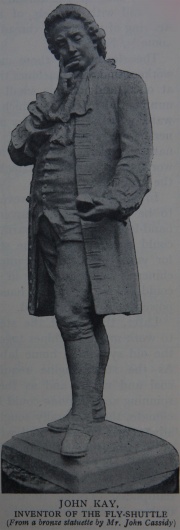John Kay (1704-1780)
John Kay (1704-1780) was the inventor of the flying shuttle, a key contribution in the mass-production of textiles. A natural inventor, his mechanical genius surpassed his commercial ability.
1704 June 17th. Born in Bury, Lancashire.
c.1718 John left school at the age of fourteen to be apprenticed to a maker of reeds (devices which separate the threads of a warp). It is said he left his master after one month, believing that he had learned all that he could from him.
1725 Anticipating a legacy when he reached the age of twenty-one, he married Ann Holt on 29 June; they had six sons and six daughters.
c.1726 Invented an improved reed for the loom - never patented but widely known as "Kay's reed".
1730 First patent taken out, for an engine for twisting reed twine.
1733 he patented a lighter shuttle, which could be used for weaving woollen or linen broad-goods. It was introduced into the local woollen industry, which enabled Kay to set up in business as a shuttle maker. He incurred heavy legal costs in taking legal action to defend his patent but failed to recoup anything from those who used his invention.
The flying shuttle greatly accelerated the speed at which weaving could be performed by allowing the shuttle carrying the weft to be passed through the warp threads more quickly and over a greater width of cloth. His invention was not appreciated by weavers, who thought it would steal their jobs; consequently he was persecuted and his constructions were damaged or destroyed.
1738 Kay patented a windmill for raising water from mine shafts
1745 he took out a joint patent with Joseph Stell of Keighley for an improved Dutch or swivel loom, driven by water power, for weaving tapes and other narrow goods.
1747 he emigrated to France, perhaps because of accumulated debts.
1747 Obtained a patent for the sole manufacture and sale in France of his wheel-shuttle
1749 he was granted a government subsidy and life pension, on condition that he cut all ties with England. To help him with the manufacturing he brought over three of his sons from England but he soon found that French weavers were counterfeiting his shuttle.
Between 1750 and 1754 he perfected and manufactured a superior card-making machine. His machines came into use in both the woollen and cotton industries of France; while the card-making machine proved of great benefit to the spinning industry, the shuttle secured general acceptance only in the 1800s.
He revisited England at least five times, and so his pension was stopped in 1759.
1764 Robert Kay appealed to the Society of Arts for a reward for his father's invention but the society criticized John Kay for his activities in France.
1770 John Kay's French pension was restored
Further inventions related to canal excavation, dock cleansing, temperature regulation, and silk manufacture.
1774 the Society of Arts awarded a bounty of 50 guineas to John Kay for his cards but not for his shuttle.
c.1780 His efforts to maintain his patent rights brought him to the attention of Richard Arkwright.
John Kay died in the south of France during the winter of 1780–81. The exact date and place remain unknown, as does the site of his grave.
His son Robert Kay stayed in England, and developed the drop box, which allowed looms to use wefts of multiple colours. Ford Madox Brown portrayed Kay and his invention in a mural painting in Manchester Town Hall.
NB
This John Kay should not be confused with John Kay the clockmaker from Warrington who was associated with Richard Arkwright in the invention of the spinning frame.
John Kay [1]
John Kay was born at Park, just North of Bury, in June 1704. Details of his life are sketchy, but he is believed to have spent some time in France before returning to his native Bury where in 1730 he had patented a thread twisting machine.
In 1733 he was to invent and introduce to the world his now-celebrated "flying shuttle". This, probably more than any other single invention, was to make the Industrial Revolution possible.
Hitherto, weavers had to physically throw a shuttle loaded with cotton from one side of the loom to another and then back again between alternating threads - a long, laborious and consequently inefficient process usually taking two men. Kay's design was to change that process forever - his flying shuttle moved from one side of the loom to another by little more than a flick of the wrist of one hand, and one man could fully operate a loom adapted to accommodate the flying shuttle. Weaving output more than doubled overnight, industrial mechanisation had begun, and the factory mass production process had begun.
Although welcomed by textile manufacturers (who perceived it as a means of increasing output and profits), Kay's invention was despised by textile workers who saw it as a threat to their livelihood. His flying shuttle was eagerly taken up by woollen manufacturers, though they were rarely so eager to pay their bills and Kay constantly teetered on the edge of financial ruin. Moreover, the fear of unemployment prompted a mob to storm Kay's property in 1753 and to ransack his house.
The invention of the flying shuttle caused many other problems for Kay, who constantly found himself in court defending his invention against its many illegal copiers. Heartbroken and disillusioned, Kay fled and disappeared into oblivion.
It is thought that he died in France, a pauper around 1780. Kay is celebrated in Bury as a local hero - Kay Gardens is named after him, and there are several local pubs named "The Flying Shuttle".


